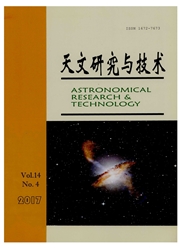

 中文摘要:
中文摘要:
天马望远镜是65 m口径全实面地平式射电望远镜,信号经赋型抛物面主反射镜和赋型双曲面副反射镜汇集后在卡塞格伦焦点处馈入低温低噪声接收系统。开展天马射电望远镜轴向偏焦研究,旨在拓展天马望远镜在低频段的接收,创新之处在于利用P波段低频振子天线作为接收机馈源,放置在距离副反射面顶点下方约1/4波长处,研究天马望远镜在P波段开展天文观测的可行性。研究内容包括P波段振子天线设计、馈源轴向偏焦位置优化以及观测性能分析。P波段振子天线作为馈源,天线最大增益45 d B,天线效率64.25%。
 英文摘要:
英文摘要:
Tianma telescope is a real surface ahazimuth radio telescope with a diameter of 65m. Its postfed, low-temperature and low-noise receiving system collects the signal collimated by the shaped parabolic main-reflector and the double curved sub-reflector. This paper studies the axial defocus effect of Tianma so as to improve its receptivity at low frequencies. A P-band dipole antenna, placed 1/4 wavelength beneath the sub-reflector, is used as the feed of the receiver to explore the performance of Tianma telescope at low frequencies. This paper is divided into three parts: the design of the P-band dipole antenna, the optimization of the axial feed defocusing position and analysis of its observed performance. Results suggest that the maximum gain of the dipole antenna is 45dB, with a high efficiency of 64. 25%.
 同期刊论文项目
同期刊论文项目
 同项目期刊论文
同项目期刊论文
 期刊信息
期刊信息
